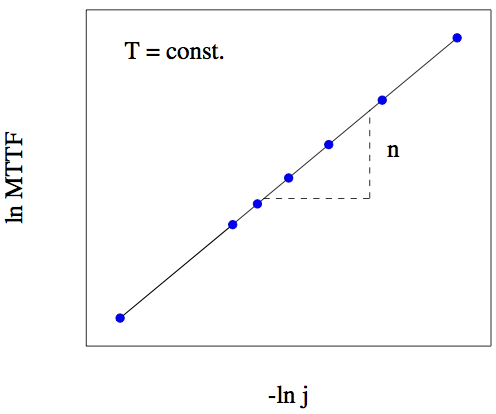Next: 1.4.4 Test Data Analysis and Lifetime Extrapolation Up: 1.4 Electromigration Failure Previous: 1.4.2 Accelerated Lifetime Test
The dependence of the MTTF of the lognormal lifetime distribution on the acceleration parameters of temperature and current density is normally described by an Arrhenius-like semi-empirical equation originally formulated by Black [12,13,14] and then modified by Blair [15] in the form
where A is a constant which contains several physical and geometrical properties of the materials, n is the current density exponent, Ea is the activation energy for electromigration-induced failure, and kB is the Boltzmann constant. Black's original empirical work predicted a failure time following a j-2 dependence [12], while later experimental studies estimated values of n generally lying between 1 and 3 [138].
The estimation of the current density exponent can be determined from the results of the electromigration accelerated tests by taking the natural logarithm of equation (1.1) as follows
| \[\begin{equation} \ln MTTF =\ln A - n \ln j + \cfrac{E_\text{a}}{k_\text{B}T}. \end{equation}\] , | (1.2) |
The sample estimate for the current density exponent n can be obtained from a linear regression analysis for one independent variable [52]. The analysis requires lifetime data from several electromigration tests conducted at different stress conditions of current density, while the stress temperature of the test structures is kept constant. A plot of the MTTF as a function of current density represents data points aligned along a straight line, which is the best fit to the data, as depicted in 1.11. The angular coefficient of the line determines the current density exponent n.
 |
It has been shown that a current density exponent n value close to 2 indicates a lognormal lifetime distribution, which corresponds to a nucleation time dominated failure [138,36,63], while a value close to 1 indicates that the dominant phase of the electromigration failure time is the void evolution [51,104]. At a constant given temperature, Black's equation generalizes to
where B and C are materials constants, tN is the void nucleation time, and tE is the void evolution time. The model in equation (1.3) assumes that the phases which dominate the electromigration-induced failure under accelerated test conditions are the same of those under device operating conditions [79].